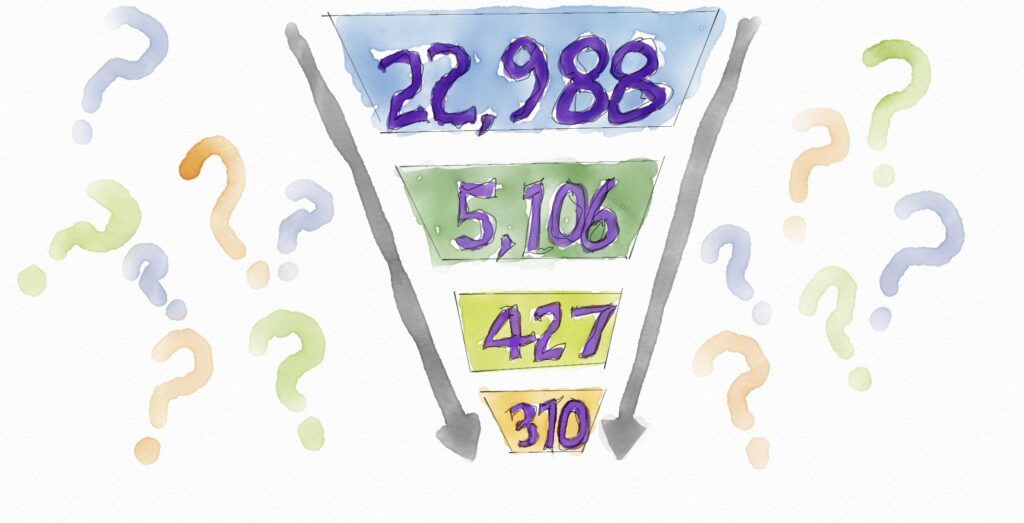Design systems are generally composed of combining UI assets, Dev code, and documentation. However, as great as this is, many organizations are finding they need a couple more things to help support designers and developers in building better experiences. Design guidelines and governance are often needed to provide more explicit guidance on the use of components.
Read moreQuantitative Data Does Not Tell You the Why
Many organizations consider quantitative data to be clear and conclusive. Making decisions based on quant data is considered a best practice that organizations either follow or aspire to follow. While in many cases it is better than guesses and hunches, it simply does not tell you the whole story. Despite how much quantitative data you are capturing, you will still not have a full enough picture to make better product decisions. Relying only on quantitative data can ruin the experience as quickly as not using any data at all.
Read moreMade Some Accessibility Updates
Well I’ll be honest, while I had checked some of the colors for the design of this site for color contrast accessibility, I had not done it for everything. I also had not even done basic accessibility checks on the overall page templates. So I spent some time this weekend working on those things. I used the excellent webaim wave accessibility evaluation tool.
Things should be improved now. However, I know until I get an actual person with an accessibility limitation to provide accessibility feedback, that it is still probably far from pleasant to browse my site here. The automated site checking tools only tell you the most basic of issues and do not give a full assessment of the actual experience, particularly for people who may use a screen reader.
Quantitative Data Does Not Always Tell the Truth

In my career I have often been involved in collecting and reporting on the usage of websites and applications through the data captured in logging / tracking systems. It can be fun to analyze and select data points and pull them into graphs and charts to be presented to leadership. However, there is a danger in relying only on quantitive data to make design decisions. People often view data collected from web/applications as definitive. It is after all a record of exactly what people clicked on and what pages / sections they visited, isn’t it? Unfortunately, this is an assumption and along with several other bad data manipulation practices you could be seeing problems where there are none.
Twitter is Awful for Discussion
Like many people, with the rise of Covid-19, I have been spending more time online. Particularly, places like Twitter, Hacker News and yes, Facebook. As anyone who has tried to have a discussion online knows, there are challenges and limitations to online communication. For all their shortcomings though I feel I have gained better understanding and even learned some things from some online discussions. However, one of the worst places to have a discussion online is twitter.
The Best UX Design Tool
People new to UX often ask which tool should they use or which tool is the best for doing our work. The short and unhelpful answer to this is that there are many different tools each with their own strengths and weaknesses. A longer answer usually starts with… The current most popular tool is Sketch and to have the broadest appeal to employers you should learn this tool. While it is a great tool capable of doing both wireframes and high-fidelity designs it lacks certain capabilities that make it less than ideal.
Designers Need to Research
There have been many articles written on whether designers should learn to code. I believe it to be part of the craft, and something that will help you be a better designer by knowing the medium in which your designs are built. However, I feel user research is one skill that is more helpful to master as a designer than coding.
Do you need an app? Probably not.
It has been noted that people spend approximately 85% of their time in apps when using their mobile devices. Based on this there are a number of consultants who believe that if you want to capture the attention of people on mobile, you need an app. If you are a small or even medium sized business, I believe this is not a valid analysis or proper extrapolation of this data.
Using Invision with Userzoom
Don’t. Well if you have to there are a few things I have learned in using an Invision prototype with the Userzoom remote user research platform. One is that the custom loading page typically does not load in the Userzoom mobile app. So don’t waste time doing one of those. If you do make one, it should be as small and lightweight as possible. I tried making a nice gif animation and no matter how small I made it, it just did not load.
The Myth of Mobile Context
There continues to persist the perception that people who use mobile devices to connect to your website have different needs from when they connect to your website with a desktop/laptop (large screen). I often hear this suggested by mobile design “experts” and other UX professionals as well as by developers and product owners. It is based on the premise that since people are on the move when using their mobile devices that they are only in need of features and functionality that meet this “mobile” context. The inference is the mobile experience then needs to be different from your home/work needs from the same site. This is a wholly unsubstantiated and erroneous premise and one that designers should discard if they intend to create great mobile experiences.